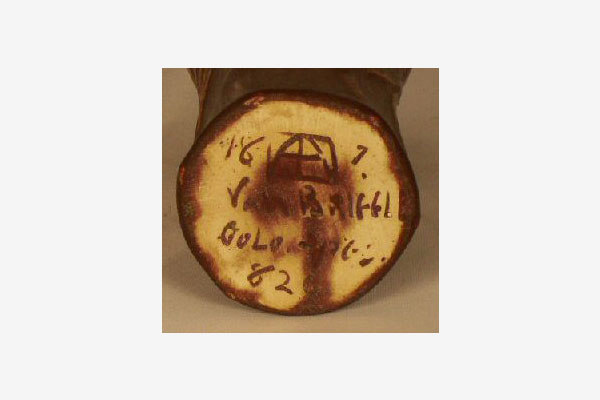Few American art pottery artists can measure up to the brilliance found in Artus Van Briggle’s clay designs, forms and  glazes. Van Briggle Pottery is known for many things, including the lovely color experimentations found in many of the patterns. In the early days, it was believed the Colorado clay played a significant role – and it likely did. But now, just as then, it’s more the artists efforts and the attention to detail that make these so collectible and valuable.
glazes. Van Briggle Pottery is known for many things, including the lovely color experimentations found in many of the patterns. In the early days, it was believed the Colorado clay played a significant role – and it likely did. But now, just as then, it’s more the artists efforts and the attention to detail that make these so collectible and valuable.
Dating Van Briggle pottery is often revealed in the differences in the color of the clay, numbers, and even residue on the bottom. The artist initials, of course, will tell a collector much about the date. The earliest Van Briggle pottery is often found with a double “A” logo along with the company name and dates in roman numerals. Remember, too, that those markings may have faded over the years. This is especially true for the pieces made between, say, 1908 and 1920. Along with those markers, collectors will also look for a shape number, three digits usually, and with a white wash at times.
Also, those art pottery designs made in the 1912 are considered quite scarce. Others dated up until 1921 are becoming increasingly difficult to find, as well. Interestingly enough, between 1915 and 1920, there was a trend in that a darker clay is often found in the designs in these specific years and can be helpful in dating the art pottery.
While those colors and finishes shifted a bit in the 1920s, there was another shift in the 1940s that seemed to set a trend, at least until the 1960s. Of course, there were other events taking place that likely played a role in the decisions of companies – and American art potters were no different. Specifically, the wars and the resulting shortages likely dictated those decisions. Some of the pieces dated within those two decades might have a buff or unglazed clay.
The more contemporary pieces, those within the past few decades, often have etcher and potter initials on the bottoms. Newer still, a system was put into place in 2000 that includes a V and a number that corresponds with the year. For instance, for a Van Briggle piece made in 2005, the marking on the bottom will be V5.
Of course, this barely scratches the surface of this well known and globally respected line of art pottery, but it is a start and for those who have just discovered what more seasoned collectors already know, every bit of information on Van Briggle Pottery helps.


